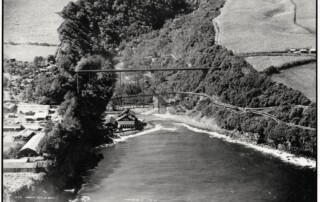Threading the Needle: Susan and Ken Forbes
KEEPING HAKALAU’S HISTORY AND VALUES ALIVE* From the 1880s, Hakalau Sugar Plantation steadily supported a growing community. Immigrants—first from China, Portugal and Japan; then from Korea, Spain and other parts of Europe—fulfilled the need for laborers, some settling in independent homesteads. By the early 1940s Hakalau had a new hospital, school gym, theater, and bridge over Hakalau Stream; its businesses were thriving. The Fair Labor Standards Act of 1938 contributed to a more urgent need for both labor and housing. Economic uncertainty and World War II only made the situation more acute; the use of machinery for harvesting became more prevalent. In 1943, the Wailea Mill merged with Hakalau Sugar Plantation, bringing production to its all-time highest. This all changed, however, after the devastating tsunami of 1946. The Hakalau Mill and some railroad bridges were destroyed, causing production to shut down for a year; the first industry-wide labor strike created further disruption. Resulting financial losses and heavy debt compounded by labor strife made it impossible for Hakalau Plantation to recover. The process of abandoning outlying villages and selling houses to workers on a removal basis began. By the 1960s the sugar industry began consolidating--Hakalau Plantation was merged with Pepe‘ekeo Sugar Company, which later became a part of Mauna Kea Sugar Company. The business was diversified into macadamia nut and bio-mass tree farming. Around 2000, parent company C. Brewer started to subdivide its agricultural lands, offering them for sale in ten-acre lots. Except for the manager’s house and a few other structures, the homes and plantation buildings below the highway were demolished for the development of new oceanside estates and subdivisions. Despite these dramatic changes, the spirit of the Hakalau community has remained strong through present [...]


